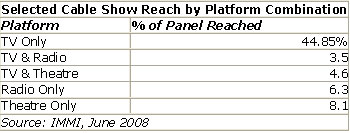Showing that advertising on more than one platform offers demonstrable benefits, some of the study highlights include:
• Six TV shows ran significant TV and radio campaigns before their new season premieres. For each of these shows, the rates of panellists that watch the program being promoted (conversion) are consistently higher among the segment exposed to a combination of platforms than among those exposed to one platform alone
• Quantifying the impact of advertising on cable television, Internet, in-cinema, and Tivo Showcases, exposure across more than one platform increases effectiveness
• For five movie releases, employing significantly large multi-platform advertising with enough exposure to quantify the effects of campaigns, the conversion for multi-platform was higher than conversion for a single platform...in some cases much higher
• The study found that the effects of increased frequency, recency and targeting did not account for the increased effectiveness of multi-platform advertising
Citing a luxury car campaign from late 2007, using multiple platforms in their advertising campaigns, the report notes that if you look at only television, you conclude the company reached 56.4% of the panel. Looking only at radio you determine the ads reached 25.1% of the panellists. However, the effective reach of the entire multiplatform campaign isn't the aggregation of these two results. There is overlap in panellists who saw an ad on television and heard it on radio.

Of the panel reached by radio, 9.1% were a unique audience not already exposed to the television campaign. In other words, the true reach of the luxury car ad campaign beyond the TV buy was increased 9.1% by their radio campaign.
In another example, when a particular cable network advertised on television only in an ad campaign for a new cable television series, they reached 52.9% of the panel. This network was able to reach an additional 14.4% of viewers by effectively using radio and in-theatre advertising. Overall, the use of multiple platforms enabled this campaign to reach 67.3% of the panel.

In addition, IMMI consolidated both ad exposure and conversion (i.e. consuming what the ad was promoting) for close to 100 television and movie campaigns. Looking at 13 prime time television shows in the 2006-2007 season on the four major networks that used both television and radio advertising as part of their campaign, nine shows ran campaigns with a large enough multi-platform presence to meet the minimum number of net impressions required for study inclusion. Of these, six showed significant conversion results.
(Conversion is the percentage of panel members who were exposed to ads for the show, then watched the show.)
In each case studied, the data showed that exposure on television-only drives less of the target behaviour than exposure on another platform in addition to television. Because the result is consistent across the board, the report concludes that there is value in constructing multiple platform campaigns that goes beyond simply maximising reach.
Find more information about IMMI, including access to the PDF file here.
Article courtesy http://publications.mediapost.com/